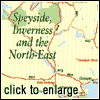|
Northern Extremeties
John O' Groats
For those that have trekked, cycled or pushed a pram
all the way from Land's End in Cornwall (Britain's supposed most south-westerly point)
to here, John O' Groats, accepted as the most north-eastern point, on a day whipping
with wind-driven rain or sleet, they must seriously wonder why they bothered.
John O' Groats is really nothing more than a tacky tourist
attraction with little to recommend apart from saying that you have been here.

The harbour and the Last House Museum are worth seeing,
the latter a tiny old cottage that contains a vivid pictorial display of the naval
activities around this area during both World Wars. There is a hotel along with several
tourist gift shops selling sea-shells and coconuts, items that have little to do
with this part of the world. Of course, you can have your picture taken at the famous
John O' Groats signpost.
For a more natural encounter, take the minor road to Duncansby
Head, some 2 miles (3km) east of 'Groats'. Its impressive rock stacks can be seen
after a short walk from the lighthouse parking area or by the boat, which leaves
from John O' Groats harbour.

The cliff faces are like high-rise apartments for
the myriad of sea-birds nesting on them in the spring and early summer. Their constant
squeals echoing off the rocky canyon are quite overwhelming. Guillemots and shags
are most common with some puffins burrowing into the grassy edges. There is a good
walk out over the headland with the path skirting the cliff edge, which is fenced
and fairly safe.
Dunnet Head on the other side of John O' Groats, taking
the A836, then the B855, is Scotland's true northernmost point. From the lighthouse,
on a windy day, you need only sit in your car to watch the incredible aerial displays
performed by sea birds catching the up-draughts from the cliffs. A climb up the grassy
rise behind the lighthouse affords some wonderful views along the coast with its
precipitous rocks. Orkney is clearly seen to the north.
Thurso
The town of Thurso is found 20 miles (32krn) west
of John O' Groats following the A836. It is a well ordered and airy little place
with a wide central square, the main shopping areas and hotels leading off it. This
was a chief trading port between Scotland and Scandinavia in the Middle Ages exporting
beef and fish.
Thurso Heritage Museum in the High Street contains
the Ulbster Stone, a Pictish relic of some note as well as exhibits gathered by the
naturalist Robert Dick. There is also a reconstruction of a croft house kitchen.
Near the harbour is Thurso's other tourist attraction, St Peter's Church, a twelfth
or thirteenth century construction that was restored in seventeenth century.
Thurso's more contemporary claim to fame is the excellent
surf it offers off its local beaches. In September and October, international surfing
championships bring enthusiasts from around the world. Windsurfing is also popular
through the summer months. The Pentland Arms Hotel is said to be the best food in
town, although you should try the Bower Inn midway between Thurso and Wick in Castletown
or the Upper Deck in Scrabster. Most visitors pass through Thurso to catch the ferry
from Scrabster, a short distance north of town, to Stromness in Orkney. There are
special days out through the summer where you catch the St Ola and, two hours later,
connect with a bus in Stromness for a tour of Orkney's mainland before returning
to Scrabster in the evening. Check with the tourist office for more details.
 Thurso's economy was considerably boosted by the construction
of Dounreay Fast Reactor Power Station some 8 miles (13km) along the A836. The facility
is no longer open for tours by the public and it is often in the news with reported
problems, so the beach is best avoided in this area. Thurso's economy was considerably boosted by the construction
of Dounreay Fast Reactor Power Station some 8 miles (13km) along the A836. The facility
is no longer open for tours by the public and it is often in the news with reported
problems, so the beach is best avoided in this area.
A few miles on is the humpy, single-track route, the
A897, leading south to Helmsdale through an area known as the Flow Country. This
is a flat, peat bog morass with large numbers of limestone lochs that offer excellent
trout fishing. It is also the home to thousands of waders and divers. It may not
be much to look at from the road but, if you know what you are looking for such as
bird life and flora, the Flow Country does have a lot to offer. The A836 carries
on towards Bettyhill and the north-west corner of mainland Scotland.
|



